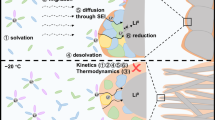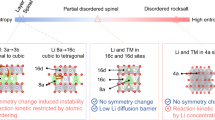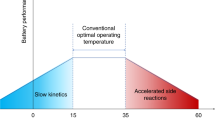Abstract
Lithium-ion batteries have revolutionized the powering of portable electronics. Electrode reactions in these electrochemical systems are based on reversible insertion/deinsertion of Li+ ions into the host electrode material with a concomitant addition/removal of electrons into the host. If such batteries are to find a wider market such as the automotive industry, less expensive positive electrode materials will be required, among which LiFePO4 is a leading contender. An intriguing fundamental problem is to understand the fast electrochemical response from the poorly electronic conducting two-phase LiFePO4/FePO4 system. In contrast to the well-documented two-phase nature of this system at room temperature, we give the first experimental evidence of a solid solution LixFePO4 (0 ≤ x ≤ 1) at 450 °C, and two new metastable phases at room temperature with Li0.75FePO4 and Li0.5FePO4 composition. These experimental findings challenge theorists to improve predictive models commonly used in the field. Our results may also lead to improved performances of these electrodes at elevated temperatures.
This is a preview of subscription content, access via your institution
Access options
Subscribe to this journal
Receive 12 print issues and online access
$259.00 per year
only $21.58 per issue
Buy this article
- Purchase on Springer Link
- Instant access to full article PDF
Prices may be subject to local taxes which are calculated during checkout






Similar content being viewed by others
References
Padhi, A. K., Nanjundaswamy, K. S. & Goodenough, J. B. Phospho-olivines as positive electrode materials for lithium batteries. J. Electrochem. Soc. 144, 1188–1194 (1997).
Ravet, N. et al. in 196th Electrochemical Society Meeting, Honolulu, Hawaii Abstract 127 (Electrochemical Society, Pennington, New Jersey, 1999).
Dominko, R., Gaberscek, M., Drofenik, J., Bele, M. & Pejovnik, S. A novel coating technology for preparation of cathodes in Li-ion batteries. Electrochem. Solid State Lett. 4, A187–A190 (2001).
Huang, H., Yin, S. C. & Nazar, L. F. Approaching theoretical capacity of LiFePO4 at room temperature at high rates. Electrochem. Solid State Lett. 4, A170–A172 (2001).
Yamada, A., Chung, S. C. & Hinokuna, K. Optimized LiFePO4 for lithium battery cathodes. J. Electrochem. Soc., 148, A224–A229 (2001).
Franger, S., Le Cras, F., Bourbon, C. & Rouault, H. LiFePO4 synthesis routes for enhanced electrochemical performance. Electrochem. Solid State Lett. 5, A231–A233 (2002).
Armand, M., Gauthier, M., Magnan, J. -F. & Ravet, N. Method for synthesis of carbon-coated redox materials with controlled size. World Patent WO 02/27823 A1 (2002).
Arnold, G. et al. Fine-particle lithium iron phosphate LiFePO4 synthesized by a new low-cost aqueous precipitation technique. J. Power Sources 119–121, 247–251 (2003).
Barker, J., Saidi, M. Y. & Swoyer, J. L. Lithium iron(II) phospho-olivines prepared by a novel carbothermal reduction method. Electrochem. Solid State Lett. 6, A53–A55 (2003).
Yamada, A. et al. Olivine-type cathodes: achievements and problems. J. Power Sources 119–121, 232–238 (2003).
Audemer, A., Wurm, C., Morcrette, M., Gwizdala, S. & Masquelier, C. Carbon-coated metal bearing powders and process for production thereof. World Patent WO 2004/001881 A2 (2004).
Subramanya Herle, P., Ellis, B., Coombs, N. & Nazar, L. F. Nano-network electronic conduction in iron and nickel olivine phosphates. Nature Mater. 3, 147–152 (2004).
Delacourt, C., Wurm, C., Reale, P., Morcrette, M. & Masquelier, C. Low temperature preparation of optimized phosphates for Li-battery applications. Solid State Ionics 173, 113–118 (2004).
Andersson, A. S., Kalska, B., Häggström, L. & Thomas, J. O. Lithium extraction/insertion in LiFePO4: an X-ray diffraction and Mössbauer spectroscopy study. Solid State Ionics 130, 41–52 (2000).
Santoro, R. P. & Newman, R. E. Antiferromagnetism in LiFePO4 . Acta Crystallogr. 22, 344–347 (1967).
Andersson, A. S. & Thomas, J. O. The source of first-cycle capacity loss in LiFePO4 . J. Power Sources 97–98, 498–502 (2001).
Rousse, G., Rodriguez-Carvajal, J., Patoux, S. & Masquelier, C. Magnetic structures of the triphylite LiFePO4 and of its delithiated form FePO4 . Chem. Mater. 15, 4082–4090 (2003).
Morgan, D., Van der Ven, A. & Ceder, G. Li conductivity in LixMPO4 (M = Mn, Fe, Co, Ni) olivine materials. Electrochem. Solid State Lett. 7, A30–A32 (2004).
Zhou, F., Marianetti, C. A., Cococcioni, M., Morgan, D. & Ceder, G. Phase separation in LixFePO4 induced by correlation effects. Phys. Rev. B 69, 201101 (2004).
Dahn, J. R. & Mckinnon W. R. Phase diagram of LixMo6Se8 for 0 < x < 1 from in situ X-ray studies. Phys. Rev. B 32, 3003–3005 (1985).
Wizansky, A. R., Rauch, P. E. & Disalvo, J. F. Powerful oxidizing agents for the oxidative deintercalation of lithium from transition-metal oxides. J. Solid State Chem. 81, 203–207 (1989).
Bykov, A. et al. Superionic conductors Li3M2(PO4)3 (M=Fe, Sc, Cr): synthesis, structure and electrophysical properties Solid State Ionics 38, 31–52 (1990).
Gorbunov, Yu. A. et al. Crystal structure of Fe2+3Fe3+4[PO4]6 . Sov. Phys. Dokl. 25, 785–787 (1980).
Dodd, J., Yazami, R. & Fultz, B. in 206thmeeting of the Electrochemical Society, Honolulu, Hawaii Abstract 425 (Electrochemical Society, Pennington, New Jersey, 2004).
Goiffon, A., Dumas, J.- C. & Philippot, E. Phases de type quartz alpha: structure de FePO4 et spectrométrie Mössbauer du Fer-57. Rev. Chimie Minérale 23, 99–110 (1986).
Coleman, S. T., Mckinnon W. R. & Dahn, J. R. Lithium intercalation in LixMo6Se8: A model mean-field lattice gas. Phys. Rev. B 29, 4147–4149 (1984).
Ceder, G. & Van der Ven, A. Phase diagrams of lithium transition metal oxides: investigations from first principles. Electrochem. Acta 45, 131–150 (1999).
Anisimov, V. I. in Advances in Condensed Matter Science (Gordon & Breach, New York, 2000).
Selwyn, L. S., McKinnon, W. R., Dahn, J. R. & Le Page Y. Local environment of Li intercalated in Mo6SezS8-z as probed using electrochemical methods. Phys. Rev. B 33, 6405–6414 (1986).
Yamada, A. & Chung, S. C. Crystal chemistry of the olivine-type Li(MnyFe1-y)PO4 and (MnyFe1-y)PO4 as possible 4V cathode materials for lithium batteries. J. Electrochem. Soc. 148, A960–A967 (2001).
Yamada, A., Kudo, Y. & Liu, K. -Y. Phase diagram of Lix(MnyFe1-y)PO4 (0 ≤ x, y ≤ 1). J. Electrochem. Soc. 148, A1153–A1158 (2001).
Yamada, A., Kudo, Y. & Liu, K. Y. Reaction mechanism of the olivine-type Lix(Mn0.6Fe0.4)PO4 (0 ≤ x ≤ 1). J. Electrochem. Soc. 148, A747–A754 (2001).
Chung, S. Y., Bloking, J. T. & Chiang, Y. M. Electronically conductive phospho-olivines as lithium storage electrodes. Nature Mater. 1, 123–126 (2002).
Delacourt, C., Wurm, C., Laffont, L., Leriche, J. B. & Masquelier, C. in Proc. MRS Fall Meeting 2004 (in the press).
Wurm, C., Morcrette, M., Gwizdala, S. & Masquelier, C. Lithium transition-metal phosphate powder for rechargeable batteries. World Patent WO 02/099913 A1 (2002).
Rodríguez-Carvajal, J. Recent advances in magnetic structure determination by neutron powder diffraction. Physica B 192, 55–69 (1993).
Acknowledgements
The authors express their sincere gratitude to D. Murphy and M. Touboul for helpful comments and discussions on this manuscript. They also thank UMICORE (Belgium) and C. Wurm for providing the pristine LiFePO4 powder.
Author information
Authors and Affiliations
Corresponding author
Ethics declarations
Competing interests
The authors declare no competing financial interests.
Supplementary information
Supplementary Information
Supplementary figures 1 and 2 (PDF 127 kb)
Rights and permissions
About this article
Cite this article
Delacourt, C., Poizot, P., Tarascon, JM. et al. The existence of a temperature-driven solid solution in LixFePO4 for 0 ≤ x ≤ 1. Nature Mater 4, 254–260 (2005). https://doi.org/10.1038/nmat1335
Received:
Accepted:
Published:
Issue Date:
DOI: https://doi.org/10.1038/nmat1335
This article is cited by
-
CHGNet as a pretrained universal neural network potential for charge-informed atomistic modelling
Nature Machine Intelligence (2023)
-
Thermodynamics of multi-sublattice battery active materials: from an extended regular solution theory to a phase-field model of LiMnyFe1-yPO4
npj Computational Materials (2023)
-
The role of solid solutions in iron phosphate-based electrodes for selective electrochemical lithium extraction
Nature Communications (2022)
-
Conducting network interface modulated rate performance in LiFePO4/C cathode materials
Rare Metals (2022)
-
Sputtered Porous Li-Fe-P-O Film Cathodes Prepared by Radio Frequency Sputtering for Li-ion Microbatteries
Scientific Reports (2019)



